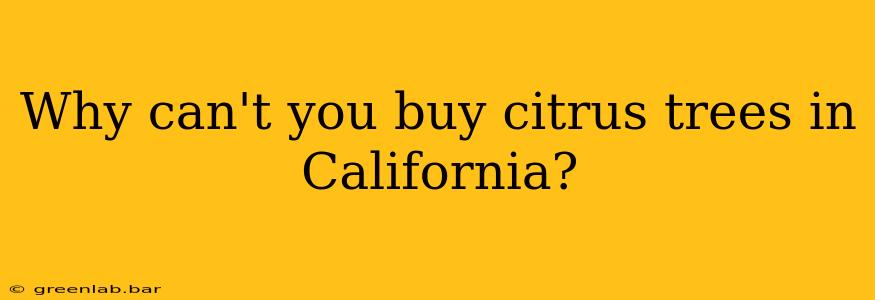The statement "You can't buy citrus trees in California" is an oversimplification. While it's true that purchasing citrus trees in California is significantly more complex than in many other states, it's absolutely not impossible. The difficulty stems primarily from the devastating impact of Huanglongbing (HLB), also known as citrus greening disease.
Understanding the Threat of Citrus Greening
Citrus greening is a bacterial disease spread by the Asian citrus psyllid, a tiny insect that feeds on citrus trees. Once a tree is infected, there's no cure. The disease causes the fruit to become bitter, misshapen, and often drop prematurely. Eventually, the tree dies. This has had a catastrophic effect on the California citrus industry, threatening the livelihood of many growers and the state's iconic citrus production.
So, Can You Buy Citrus Trees in California?
Yes, but with significant restrictions and caveats. The California Department of Food and Agriculture (CDFA) actively works to prevent the spread of HLB. This involves strict regulations surrounding the sale and transportation of citrus trees. These regulations aim to ensure that any trees sold are as disease-free as possible.
What to Expect When Buying Citrus Trees in California:
- Limited Availability: You won't find citrus trees readily available at every garden center or nursery. Many nurseries have stopped selling them altogether due to the risks and regulations.
- Certified Trees: If you can find them, you'll likely only find trees that are certified as disease-free by the CDFA. This certification process involves rigorous inspections and testing to ensure the tree is free from HLB and other harmful diseases.
- Specific Varieties: The varieties of citrus trees available may be limited to those considered more resistant to HLB, or those grown in controlled environments.
- Increased Cost: The certification process and extra precautions involved add to the cost of these trees, making them more expensive than trees sold in states without such strict regulations.
- Potential Quarantines: Depending on your location and the regulations in place, you might encounter quarantines or restrictions on planting certain citrus varieties.
What You Can Do to Support California Citrus:
Even if you can't buy a citrus tree right now, there are ways to support the California citrus industry and the efforts to combat HLB:
- Buy California Citrus: Support local growers by purchasing California-grown oranges, lemons, grapefruits, and other citrus fruits.
- Report Suspicious Citrus Trees: If you see a citrus tree showing signs of HLB (yellowing leaves, mottled fruit), report it to your local agricultural authorities immediately. Early detection is crucial in managing the spread of the disease.
- Support Research: Contribute to organizations and initiatives dedicated to researching HLB and developing effective control measures.
In conclusion, while the challenges are real, buying citrus trees in California isn't entirely impossible. The restrictions are in place to protect the state's valuable citrus industry from a devastating disease. By understanding the complexities surrounding citrus greening and supporting the efforts to combat it, we can all play a part in preserving California's citrus heritage.

